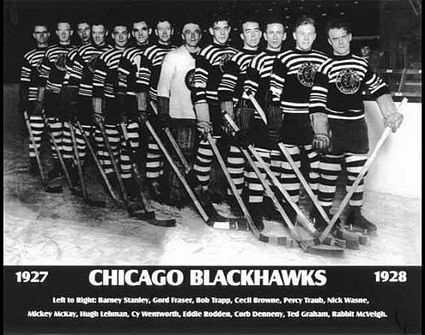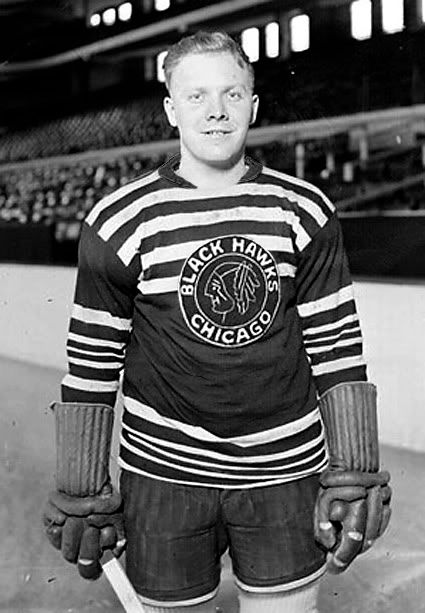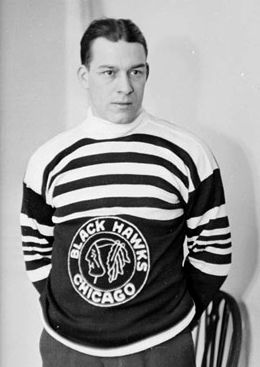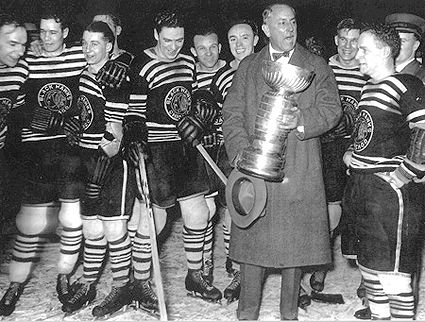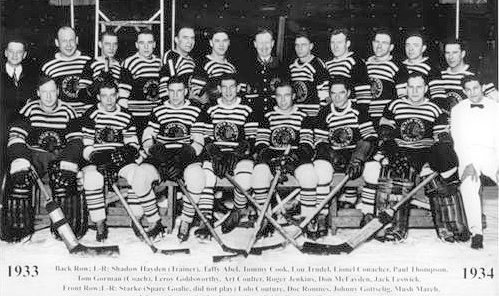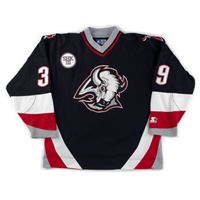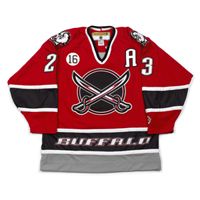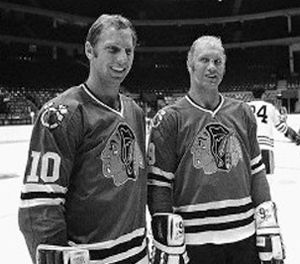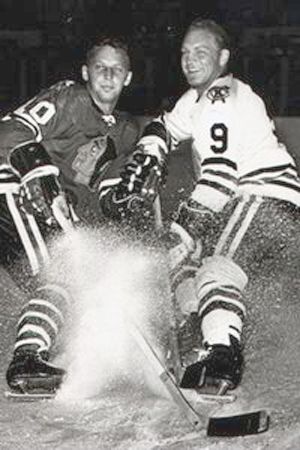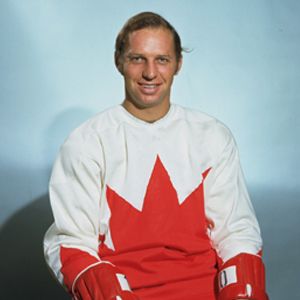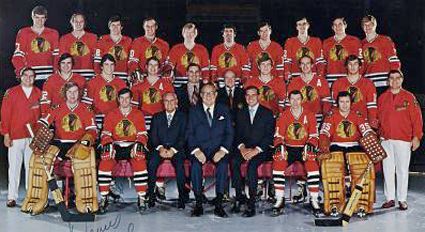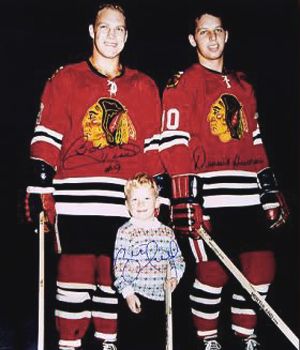Friday, November 23, 2012
Black Friday - 1927-28 Chicago Black Hawks Jersey
In honor of the official kickoff to the Christmas shopping season and the madness known as "Black Friday", today we take a look at the first black jersey worn in the National Hockey League.
The Chicago Black Hawks entered the NHL in time for the 1926-27 season wearing a white jersey adorned with multiple black stripes in the art deco style of the times.
The majority of the team's players came from the Portland Rosebuds of the defunct Western Hockey League. The club was named after their owner Frederic McLaughlin's army unit, of which he had been a commander, the 333rd Machine Gun Battalion of the 86th Infantry, nicknamed the "Black Hawk Division". It was McLaughlin's wife Irene who designed the team's Indian head logo.
Despite leading the league in goals scored with 115, they also allowed the most goals with 116 and finished under .500 with a 19-22-3 record. They would qualify for the playoffs, but fell to the Boston Bruins 6-1 and tied them 4-4 in Game 2 to lose the total goals series 10-5.
For their second season, the club would debut brand new sweaters, which were a complete color reversal of their inaugural sweaters, now black with a multitude of white stripes. This sweater was the first black sweater in NHL history.
While the sweaters colors were reversed from year one, the crest was not and remained white on black. In all honesty, it too probably could have had it's colors reversed as well for greater contrast and legibility.
Today's featured jersey, a 1927-28 Chicago Black Hawks Teddy Graham jersey, shows the higher placement of the crest for the 1927-28 season, which overlapped the lower two chest stripes.
For 1928-29 and subsequent seasons, the crest was lowered below the striping and the collar would change from black to white as shown below in this photo or Art Somers from the 1929-30 season.
The Black Hawks would wear these sweaters for seven seasons and win their first Stanley Cup wearing them in 1934.
They would begin the next 1934-35 season wearing them, but midway through the schedule they would debut a new, short-lived set of black sweaters with a wide white chest stripe with red trim which would only be worn for the remainder of that season only.
As most teams only had a single style of sweater through the 1930's worn for all games regardless of home or road, no other team would introduce another black jersey until the 1948-49 season when light and dark "home" and "road" jerseys had by then become the accepted practice, which allowed the Boston Bruins to introduce their first black sweater, knowing Chicago would now be able to wear their white sweaters to differentiate themselves from the Bruins.
Labels:
Black Friday,
Chicago Blackhawks
Thursday, November 22, 2012
Hockey Thanksgiving
With today being the American Thanksgiving, we decided to forego the usual format and list The Top Ten Things We Are Thankful For - Third String Goalie style.
#10 - College and juniors jerseys - Simple, no frills jerseys with classic styling. You've got your team colors and your logo. What more do you need?
#9 - Kathryn Tappen. She actually makes sitting through Columbus Blue Jackets "highlights" on the NHL Network something to look forward to.
She absolutely knows her sports without question while nearly balancing out us having to look at Jamie McLennan.
She absolutely knows her sports without question while nearly balancing out us having to look at Jamie McLennan.
#8 - Minor league jerseys. Freed of the constraints of tradition and the fear of failure that limits NHL clubs who can't afford to guess wrong due to the huge amounts of retail sales their jerseys generate, at times minor league jerseys are allowed to experiment and stretch the limits of creativity, which can pay off with some terrific sweaters and even better number fonts.
#7 - Awesome alternate jerseys. As wrong as the bad ones are, the best ones are just so right. This is a prime example of the best of the best NHL alternates, a classy, unique new logo and great use of colors. Perfection on ice.
#6 - Throwback jerseys. Nothing gets us going like a throwback. It's one of the main reasons our collection centers around the 1991-92 season, that was the year that the Original 6 teams wore the first throwback jerseys in NHL history.
The recent addition of the Winter Classic, and the re-emergence of the Heritage Classic, has assured us of at least a couple of beauties every season, be they straight throwbacks or faux-backs, such as the Boston Bruins Winter Classic jerseys, which borrowed elements from various Bruins jerseys of the past.
#5 - Awful alternate jerseys. The jerseys we love to hate, courtesy of The Class of '96. What would this blog be without The Burger King and the Wild Wing?
#4 - National team jerseys. Herb Brooks said it best, "You're looking for players whose name on the front of the sweater is more important than the one on the back." Nothing like suiting up for your home country in a short tournament where every game counts.
#3 - Patches. Nothing sets a jersey apart like a tournament, anniversary, memorial, event, Stanley Cup Finals or even sponsorship patch. That kind of attention to detail always scores points with us.
#2 - YouTube. Where to begin with this one? Incredible goals, comic moments, of course all the brawls plus the obscure, hilarious and unexpected. You just never know what YouTube has in store from one day to the next. The only thing that we dislike about it is when we embed a video from YouTube and it's taken down for whatever reason later on.
#1 - The Buffalo Sabres. Time and again, most of our favorite stories always seem to involve the Buffalo Sabres. Their first draft pick in history was awarded to them by a spin of a wheel, they once drafted an imaginary Japanese player, the city was paralyzed by a snowstorm for a week, causing 300 people to seek refuge in their arena and limiting the club to just 15 players for a road game in Montreal where the plucky warriors tied the defending Stanley Cup champions 3-3. They hosted the first Winter Classic, signed the first Russian to defect to the NHL and once played a playoff game in a thick fog in an arena haunted by bats. They haven't won the Stanley Cup, but they've won our hearts with their quirky and unique tales. God bless Punch Imlach.
Then there is the club's jersey history, which stretches from the sublime to the ridiculous having featured logos which depict a buffalo, a goat and a banana slug...
...with a few unexpected twists along the way.
We'd love to hear your favorites in the comments section below after you are done taking your post-turkey dinner nap today, and with tomorrow being "Black Friday", please consider visiting our advertisers in the column to the right when shopping for yourself or the hockey fan on your gift list.
Have a happy Thanksgiving a drive safely!
Monday, November 19, 2012
1972-73 Chicago Black Hawks Dennis Hull Jersey
Playing his career in the shadow of his older brother and teammate Bobby Hull, Dennis Hull was born on this date in 1944.
Dennis and Bobby Hull
Hull played junior hockey with the St. Catharines Teepees of the Ontario Hockey League beginning in the 1960-61 season and gave no indication of what was to follow with two seasons of 10 and 18 points. The team became sponsored by the Chicago Black Hawks in 1962 and thus became the St. Catharines Black Hawks. In 1962-63 Hull raised his point total to 48 before impressing the following season with 48 goals and 97 points, doubling his total from the previous season.
He made the Chicago roster in 1964-65 and saw action in 55 games, scoring 10 goals as a rookie. The club determined he needed some additional seasoning in 1965-66, and Hull was sent to the minors for 40 games with the St. Louis Braves. He also played 25 games with Chicago that season, but his lone goal raised cause for concern.
Those fears were calmed in 1966-67 when he played in all 70 games, scoring 25 goals and 42 points. Two seasons later Hull registered his first 30 goal season. The only problem for Dennis was that Bobby was in his 12th season for the Black Hawks, had ten seasons of 30 goals or more and scored an NHL record 58 goals that same season. Such was life for Dennis Hull in the NHL.
Dennis had a very good 1970-71 season, setting a career high in goals with 40 and nearly catching Bobby, who had 44 while now having been paired with Pit Martin and Jim Pappin on the "MPH Line", which came from the trio's last initials. The team also excelled, making a playoff run that would take them to the first Stanley Cup Finals in Dennis' career.
For their final season as teammates, Dennis had his third 30 goal season and set a new personal best with 69 points. For 1972-73, the hockey world was turned on it's ear with the arrival of the World Hockey Association, who made Bobby their marquee attraction by signing him away from the Black Hawks by virtue of a million dollar contract.
This defection resulted in Bobby being blacklisted from the Team Canada roster for the 1972 Summit Series against the Soviet Union, despite his undoubted offensive capabilities. Dennis though, was still a member of the NHL and became part of Team Canada, at the urging of his brother following Dennis' thoughts of boycotting the series in support of Bobby. Dennis was paired with New York Ranger teammates Jean Ratelle and Rod Gilbert, and scored two goals and four points in the four games he played in.
With the 50 goal scorer Bobby now out of the lineup, everyone feared what the impact would be on the Black Hawks, but the MPH Line stepped up to fill the void, and all three players hitting at least 90 points and raising their previous season total by a minimum of 21 which saw Dennis Hull score 39 goals and set a career high with 90 points. That season, Chicago would again return to the Stanley Cup Finals for the second time in Hull's career.
The 1972-73 Chicago Blackhawks
In 1973-74, Hull would play in 74 games, his eighth consecutive season of 70 games or more, a streak broken the following season when he played in "just" 69 games. He followed that with playing 80 and then 75 in his final two seasons with the Black Hawks. In all, he would play 824 games out of a possible 848 games once he established himself as a regular with the club 11 seasons earlier, a rate of 97% for the model of reliability and consistency he, and the MPH Line, provided the Black Hawks.
Hull was acquired by the Detroit Red Wings for the 1977-78 season, his final one before retiring as a player.
His final NHL totals are 959 games played with 3030 goals and 351 assists for 654 points and he would appear in six NHL All-Star Games, including the 1974 version with linemates Martin and Pappin.
Known for his outgoing personality and sense of humor, he wrote a book entitled (in reference to his nephew and Bobby's offensively gifted son Brett Hull) "The Third Best Hull - I would have been fourth best but they wouldn't let my sister Maxine play."
Bobby, Brett and Dennis Hull
Today's featured jersey is a 1972-73 Chicago Black Hawks Dennis Hull jersey as worn during Hull's career year when he played for Team Canada in the 1972 Summit Series and then went on to the best season of his NHL career with 90 points.
The Black Hawks adopted this jersey style in 1955 and it has become an icon in the world of hockey, remaining essentially unchanged for over 55 years.
Today's video section begins with highlights of the MPH Line in action.
Hull has gone on to a career as a public and motivational speaker, and here he is telling some of his humorous stories.
Here are highlights of Game 6 of the 1972 Summit Series, in which Hulls scores a goal for Team Canada.
Finally, a pair of intertwined interviews from WGN TV in Chicago, hosted by long time Cubs announcer Jack Brickhouse. Bobby clearly got the better background for his interview...
Labels:
Chicago Blackhawks,
Hull Dennis
Subscribe to:
Posts (Atom)


